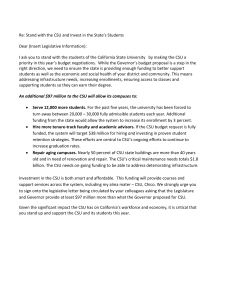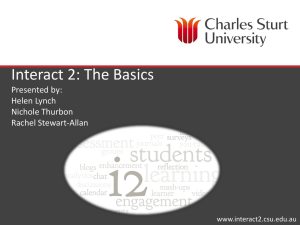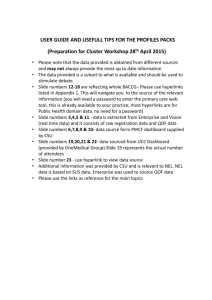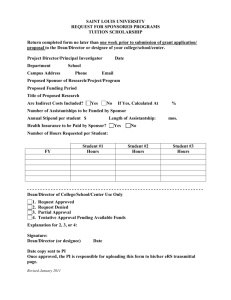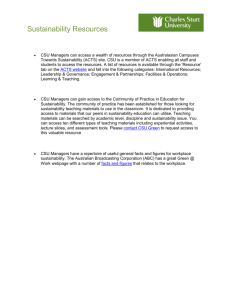Project Management & Business Analysis
advertisement
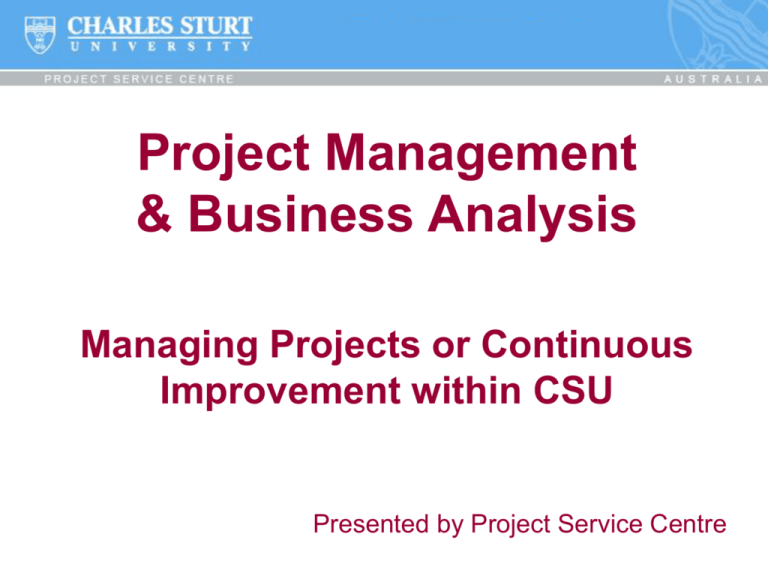
Project Management & Business Analysis Managing Projects or Continuous Improvement within CSU Presented by Project Service Centre Course Objectives Understand the importance of project management and business analysis to CSU Develop project management and business analysis skills COURSE OBJECTIVES Obtain a framework for project management and business analysis Familiarise with project management and business analysis principles Project Service Centre - WHY CSU STRATEGY KEY OBJECTIVE 1 KEY OBJECTIVE 2 KEY OBJECTIVE 3 KEY OBJECTIVE 4 COURSE PLAN RESEARCH PLAN LEARNING & TEACHING PLAN INSTITUTIONAL DEVELOPMENT PLAN A project could deliver on any of the 4 University Plans The Project Service Centre exists to deliver on institutional development by way of providing project services or coaching PROJECT SERVICE CENTRE OPERATIONAL PLAN OBJECTIVE 1 OBJECTIVE 2 PROVIDE APPROPRIATE PROJECT MANAGEMENT SERVICES TO FACILITATE CHANGE WITHIN CSU BUILD ORGANISATIONAL AWARENESS AND CAPABILITY IN PROJECT MANAGEMENT Project Service Centre - WHAT PROJECT SERVICE CENTRE OPERATIONAL PLAN OBJECTIVE 1 OBJECTIVE 2 PROVIDE APPROPRIATE PROJECT MANAGEMENT SERVICES TO FACILITATE CHANGE WITHIN CSU BUILD ORGANISATIONAL AWARENESS AND CAPABILITY IN PROJECT MANAGEMENT 1/ MOSTLY DOING ROADMAP 1/ SOME DOING AS IS To achieve ‘TO BE’ we need to build capability: TO BE 2/ SOME BUILDING CAPABILITY > outside PSC to enable all CSU staff to facilitate change effectively > within PSC to enable them to effectively support staff who are facilitating change 2/ MOSTLY BUILDING CAPABILITY Definitions of…. Project Management & Continuous Improvement Projects v Operational Work w “A temporary endeavour undertaken to create a unique product or service” (PMBOK 2000) w Aim to meet objectives with a definite beginning and end date PROJECTS w Have a unique outcome which is aimed at changing the status quo w Utilise resources w Have resource contraints w Require activities to be planned, executed & managed w Is ongoing and repetitive w Continues to deliver on objectives OPERATIONAL w Repeats over a period of time and operates within the existing status quo Continuous Improvement at CSU Examples of individual views Innovation Innovation Continuous Improvement Continuous Improvement Maintenance & Operations Maintenance & Operations Operational Staff Senior Management Continuous Improvement at CSU Example of an enterprise view Senior Management Innovation Continuous Improvement CSU Position Level Maintenance & Basic Operation Operational Staff Effort / Time Continuous Improvement V Innovation DOING SOMETHING BETTER DOING SOMETHING NEW Inward looking Outward looking Small steps Conventional Know-how Big step Effort Investment Process-oriented Result-oriented Technological Break-through Improvement at CSU Enterprise View Innovation DOING SOMETHING NEW Continuous Improvement DOING SOMETHING BETTER Maintenance & Basic Operation Project Management at CSU We all have to get from „AS IS‟ > „TO BE‟ somehow... AS IS ‘AS IS’ being the current situation TO BE ‘TO BE’ being the desired state Project Management at CSU ...and we all need to think about the same things...what, who, why, etc... ...but which path will maximise the quality of the ‘TO BE’ situation...? WHO WHAT WHY AS IS TO BE WHERE WHEN HOW The Project Management Process WHO AT W H PLAN INITIATE ANALYSE DESIGN CONSTRUCT CLOSE TEST CONTROL H W ER MANAGE CHANGE E HOW EN PLAN EXECUTE W H INITIATE Y PROJECT SERVICE CENTRE PROJECT LIFECYCLE FRAMEWORK H W PROJECT MANAGEMENT FRAMEWORK IMPLEMENT CLOSE So what is Project Management? Project Management is a structured approach to the delivery of the „TO BE‟. WHO AT W H Y PLAN INITIATE EXECUTE PROJECT SERVICE CENTRE PROJECT LIFECYCLE FRAMEWORK PLAN ANALYSE DESIGN CONSTRUCT CLOSE TEST CONTROL H W ER MANAGE CHANGE E HOW EN INITIATE W H AS IS H W PROJECT MANAGEMENT FRAMEWORK IMPLEMENT CLOSE TO BE Project Management focuses on 3 Elements... TASKS PEOPLE EXPECTATIONS CONTROL and... ...continually manages pressures associated with a project through planning, analysis and the use of control tools and techniques. TIME RISKS ISSUES BUDGET ENVIRONMENT RESOURCES QUALITY SCOPE What is Project Management? TIME PE OP LE QUALITY TR OL OL TR CO N CON TROL OL TR KS EXPECTATIONS N CO BUDGET RESOURCES S TA ISSUES N CO RISKS ENVIRONMENT CONTROL SCOPE Why are we doing the project / improvement? Continuous Path to Improvement The Plan Implement Review Improve (PIRI) Cycle is based on a continuous improvement approach to AS IS > TO BE WHO Y W H AT H W P I PLAN IMPLEMENT I R IMPROVE REVIEW E W H ER EN H W HOW Whether a project framework or continuous improvement cycle is used to achieve „TO BE‟... PSC PROJECT LIFECYCLE FRAMEWORK OR PIRI CONTINUOUS IMPROVEMENT CYCLE ...it is important that business analysis is undertaken to ensure the “Change Intent” is met and that the quality of „TO BE‟ is maximised. What is Business Analysis? Business analysis is a mindset that focuses on... WHO WHAT WHY BUSINESS ANALYSIS WHERE WHEN HOW ...which are at the core of all the things we need to think about. So - in short…Business analysis is the conduit between the requested outputs and the solution created to address the identified need – or the conduit between the AS IS > TO BE WHO WHAT AS IS WHY BUSINESS ANALYSIS WHERE WHEN HOW TO BE A Business Analysis Framework ...involves a set of activities designed to achieve a quality outcome. WHO BUSINESS ANALYSIS FRAMEWORK Understand the business need and strategic direction WHAT Plan the requirements development process Gather information DEFINITION WHY Formulate requirements Ensure shared understanding of requirements FUNCTIONAL REQUIREMENTS REQUIREMENTS WHERE WHEN HOW Formulate how requirements will be implemented Ensure operational acceptance of implementation The Needs Hierarchy depicts the relationship between the business needs which business analysis addresses TIME / LEVEL OF DESCRIPTION OF NEEDS NEEDS HIERARCHY EACH LEVEL OF THE HIERARCHY MUST DRIVE THE LEVEL BELOW – THEREFORE EACH ITEM MUST BE CROSS REFERENCED TO THE LEVEL ABOVE 4 A Project or Improvement idea is driven PROJECT / IMPROVEMENT OBJECTIVE HIGH LEVEL DESCRIPTION OBJECTIVE EXPLANATION OF HIERARCHY COMPONENT by an understanding of the current situation and the desire or need to change the future situation. 4 Objectives establish the goals that the change OBJECTIVE should achieve, e.g. legislative compliance. Objectives must be measurable. RELEVANT METHODOLOGY DOCUMENT PROJECT DEFINITION This document can guide you in capturing the relevant information required to make an informed decision about whether the proposed change should be implemented. Covering: IDEA DRIVERS WHAT WHO WHY WHEN WHERE 4 Initial Scope sets the parameters for the change to ensure the objectives will be addressed – what areas are included in the change and what areas are not included in the change. SCOPE STAKEHOLDERS COMMITMENT ‘AS IS’ SITUATION TIME ‘TO BE’ SITUATION 4 Deliverables are what is expected to be DELIVERABLE DELIVERABLE achieved by implementing the change, e.g. business processes and procedures to support the introduction of XYZ. DELIVERABLE 4 Requirements are statements which define what needs to be provided by a ‘solution’ to achieve the deliverables. LOW LEVEL DETAIL REQUIREMENT REQUIREMENT REQUIREMENT REQUIREMENT 4 Refined Scope is the review and validation of the ‘Initial Scope’. The initial scope may change as a result of formulating requirements during this phase. WHAT 4 Functional Requirements describe the LOW LEVEL DETAIL HOW FUNCTIONAL REQ FUNCTIONAL REQ FUNCTIONAL REQ FUNCTIONAL REQ FUNCTIONAL REQ FUNCTIONAL REQ behaviours of the requirements that the solution needs to manage. 4 Performance Criteria describe what is to be used to judge the solution’s performance. 4 Business Rules describe the governance that must apply to the solution. PARAMETERS TIME OBJECTIVE BUDGET REQUIREMENTS Requirements must be: SPECIFIC MEASURABLE CLASSIFIABLE FUNCTIONAL REQUIREMENTS DETAILED PROCESS GOVERNANCE REQUIRED OUTCOME Why Projects Fail LACK OF EFFECTIVE SPONSOR INVOLVEMENT INSUFFICIENT KEY STAKEHOLDER BUY-IN POOR SCOPE DEFINITION INSUFFICIENT KEY STAKEHOLDER COMMITMENT COMMON CAUSES OF PROJECT FAILURE POOR ESTIMATING SCOPE CREEP POOR PROJECT CONTROL Most projects fail to deliver to the basic criteria of on time and budget… Cancelled 31.1% Results of analysis of 8380 projects in 365 organisations On time & budget 16.2% Challenged 52.7% Fifteen reasons for projects failing Project Mgr View Senior Mgr/ Sponsor View Reason Project Mgr View Senior Mgr/ Sponsor View Reason Insufficient planning Staffing problems Unrealistic project plan Technical complexities Project scope underestimated Priority changes Customer/management changes No team commitment Insufficient contingency planning Uncooperative support groups Inability to track progress Sinking team spirit Inability to detect problems early Unqualified project personnel Insufficient checkpoints Fifteen reasons for projects failing Project Mgr View Senior Mgr/ Sponsor View Reason Project Mgr View Senior Mgr/ Sponsor View Reason 1 10 Insufficient planning 9 4 Staffing problems 2 3 Unrealistic project plan 10 2 Technical complexities 3 8 Project scope underestimated 11 6 Priority changes 4 1 Customer/management changes 12 10 No team commitment 5 14 Insufficient contingency planning 13 12 Uncooperative support groups 6 13 Inability to track progress 14 7 Sinking team spirit 7 5 Inability to detect problems early 15 15 Unqualified project personnel 8 9 Insufficient checkpoints Successful? From who‟s perspective? The product or the project? How and when is this measured? Where do I start? You have been appointed to manage the project – so what next?????? Process Description Outputs 1. Sponsor/Owner Engagement: •Familiarisation with the idea and research •Meet with Sponsor/Owner to determine Notes that should be verified by the Sponsor/Owner to ensure shared understanding – Project / Improvement name – Objectives of the Project / Improvement – What you will work on and not work on – Determine Deliverables – Ask who should be involved – Determine Steering committee nominations 2. Stakeholder Context: • Complete an initial Stakeholder Map • Confirm with Sponsor Stakeholder Map Who should be involved? WHO - Stakeholders 4 Stakeholder Maps are a simple method to identify who needs to be involved in a project or improvement 4 It is a living diagram which should be revisited throughout the life of the project or improvement MORE INFO yourCSU http://www.csu.edu.au/staff/yo urcsu/who_stakeholders.html Exercise Customers | Recipient of a product output (service, product, information) Partners | Partners include those that are jointly engaged in the delivery of the product Governance | the systems and processes in place for ensuring proper accountability and openness in the conduct of the University‟s business. Service Providers / Enablers | Provides resources and support mechanisms to enable the product delivery WHO - Roles and Responsibilities The Sponsor is the owner of the Project and provides funds to the project A Project Manager is responsible for meeting the client‟s requirements such that the project‟s outputs are fit for purpose and are delivered within the agreed timeframe and cost. A Business Analyst is the conduit between those requesting the outputs of a project (the project sponsor and clients) and those who are required to create the outputs (the project team). A Business Expert provides business expertise, the business rules and guidance on how the business operates to the project Key Stakeholders are any people who have an interest in the project. They may be individuals or groups. The Steering Committee is responsible for ensuring the outcomes of the project are met in accordance with the Project Definition. Project Team Members are made up of a number of technical and administrative personnel and may not fall into the category of a business expert or business analyst. What should I do next? You have been appointed to manage the project – so what next?????? Process Description Outputs 3. Kick Off / Rapid Planning (RAP) Session: • Arrange Kick Off / RAP Session with representatives from areas identified in the initial Stakeholder Map • Organise agenda and expected outcomes • Deliver Kick Off / RAP Session • Agenda • Stakeholders • Knowledge 4. Outputs review: • Document raw outputs from Kick Off / RAP Session and have attendees verify content • Distribute final outputs to Sponsor/Owner and Steering committee for comment and feedback • Scope • Objectives • Deliverables • Risks/Issues • Dependencies 5. Project Definition: • Populate Project definition template from Kick Off / RAP Session feedback and subsequent discussions • Circulate to steering committee for signoff • Project Definition Document WHAT - Interview or Workshop? Interview when: Workshop when: 4 requirements are detailed 4 requirements are high level 4 requirements cover many areas of knowledge that have specific individuals who are the experts 4 requirements are focused on one area of business in which the participants have knowledge 4 differing opinions are likely or are sought Remember – be aware of your objectives 4 consensus is being sought 4 All stakeholders are available WHAT - Sample Agenda Objective: To discuss the requirements surrounding the “AS IS” to “TO BE” Welcome and introductions What factors will impact the project? Set the scene Brainstorm future approach Glossary of terms Review what‟s in and what‟s out of scope What do we want to achieve? What are the next steps? Who is going to be involved? Identify working party How will this change the current model? Delegate activities What needs to be done? Schedule next meeting Identify issues & risks Wrap – up Next Steps 1. Document Discussion outcomes 2. Distribute minutes for comments and actioning 3. Complete Project Definition 4. Continue Business/project requirements articulation Remember – be aware of your “objectives” Workshop Execution Have a „Parking Lot‟ Publish outputs for review & comment Understand the next steps SOME TIPS FOR HOLDING A WORKSHOP Have a Glossary of Terms Make it participative The Needs Hierarchy When do we do it? Five Project Management Processes* Process Description 1. Project Initiation: defining and authorising the project or phase 2. Project Planning: defining and refining objectives and seeking the best of alternative courses of action to attain these 3. Project Execution: carrying out the project plan by executing the activities therein 4. Project Controlling: ensuring project objectives are met by monitoring and measuring progress regularly and taking corrective action when needed 5. Project Closure: formalising acceptance of the project or phase and bringing it to an orderly end *Adapted from PMBOK 2000 A Project Management Process is an example of a project path to improvement. Below is the CSU Project Lifecycle / Project Management Framework Project Phases & Effort How do we manage it? Project Management is… the management of these elements: TASKS PEOPLE CONTROL EXPECTATIONS What are the main pressures on a Project that require constant management? TIME RISKS ISSUES BUDGET ENVIRONMENT RESOURCES QUALITY SCOPE What is Project Scope? 4 Initial Scope sets the parameters for the change to ensure the objectives will be addressed – what areas are included in the change and what areas are not included in the change. 4 Refined Scope is the review and validation of the ‘Initial Scope’. The initial scope may change as a result of formulating requirements during this phase. PROJECT DEFINITION DOCUMENT PROJECT REQUIREMENTS DOCUMENT Managing the Project Scope “Scope creep” occurs if project work does not address the Scope items which are captured in the Project Definition (refer to Needs Hierarchy). “Out of Scope” items assist in managing expectations and tasks. Project Managers are required to ensure that all tasks performed by the project is “In Scope” and work that is “Out of Scope” is not performed. If the Scope needs to change, the Project Manager uses a “Change Request” to identify what impact the Scope change will have on the original plan. Change Requests must be authorised by the Project Sponsor/Owner. Maintain a Change Request Register to manage overall project expectations. Tools, Templates & Resources Project Lifecycle Framework Tools, Templates and Resources are all found at: www.csu.edu.au/division/psc Project Control Kit The Control Kit 4 The Control Kit provides a means of managing the project / improvement 4 It also provides team members with a one-stop shop for information TEAM MEMBERS DOCUMENT CONTROL & LOCATION ISSUES & RISKS REGISTERS An ISSUE is something that HAS happened AND NEEDS TO BE ADDRESSED CONTROL KIT MEETING MINUTES ACTION LISTS SCOPE CHANGE CONTROL A RISK is something that MAY happen Team Meetings Write up notes as soon as possible after the meeting KEY FINDINGS EMERGING THEMES ACTIONS PROJECT MINUTES DECISIONS / RECOMMENDATIONS GAPS IN INFORMATION Techniques People Management - Common Factors ASSUMPTIONS WORKPLACE CULTURE SITUATIONAL FACTORS EMOTIONAL FACTORS COMMON PEOPLE MANAGEMENT FACTORS SEMANTICS KNOWLEDGEBASE ETHICS ORGANISATIONAL STATUS Be aware of communication barriers i.e. obstacles that restrict effective communication HIDDEN AGENDAS ABSENCE OF APPROPRIATE CHANNELS PREJUDICES BACKGROUND NOISE / CLUTTER COMMON CAUSES OF COMMUNICATION BARRIERS EMOTIONAL SENSITIVITY INFORMATION WITHHOLDING MANAGEMENT BY MEMO GEOGRAPHICAL SEPARATION Identifying Significance To determine overall significance: Ask what is important to you in ABC? To determine relative significance: Ask which is more important to you – X, Y or Z? Reaching Consensus 1/ IDENTIFY AREAS OF AGREEMENT & CLEARLY STATE DIFFERENCES 4 State positions and perspectives as neutrally as possible 4 Document a summary of concerns 2/ FULLY EXPLORE DIFFERENCES 4Explore each perspective and clarify 4Involve everyone in the discussion – avoid one-on-one debates 4 Identify common ground and attempt to develop a compromise 3/ REACH CLOSURE AND ARTICULATE THE DECISION 4Ensure all team members have expressed their perspective 4 Detect when the team is approaching consensus 4 Ask each member if they agree and will they support the decision 4Document the decision The 6 Interrogators WHO WHAT WHY “I keep six honest serving men (They taught me all I knew); their names are What and Why and When and How and Where and Who.” ...Rudyard Kipling. WHEN WHERE HOW The 5 Whys SYMPTOM 1/ WHY? Moving from symptom through to root cause The goal of applying “The 5 Whys” method is to get to the cause / effect relationships underlying a particular problem 2/ WHY? 3/ WHY? 4/ WHY? 5/ WHY? ROOT CAUSE The Magic Qualifier Specifically… To elicit better quality information add this word to the question. We then approve the application... Specifically how do you approve the application? The Alternate Close Lock in a Commitment by… using the Alternate Close technique by offering option A or option B When can you get that to me? Early or late in the week? Thursday or Friday? Morning or afternoon? 10 or 11am? Summary & Wrap Up CHANGE WILL HAPPEN!!!!!!!!!!!!! Change is inevitable. Changing the scope may change the objectives. Changing the objectives may change the stakeholders. Make sure you have clearly documented and cross referenced these changes against the Needs Hierarchy. Once you have it all planned... EXPECT IT TO CHANGE!!!!!!!! You now have tools to kick off a project and manage change within the project! Recap Speak to the Sponsor/Owner Identify your Stakeholders Organise a Kick Off meeting Create the Project Definition Set up your Control Kit Use the Templates & Techniques Ask for help when needed Manage the Balloon TIME PE OP LE QUALITY TR OL OL TR CO N CON TROL OL TR KS EXPECTATIONS N CO BUDGET RESOURCES S TA ISSUES N CO RISKS ENVIRONMENT CONTROL SCOPE Course Objectives Understand the importance of project management and business analysis to CSU Develop project management and business analysis skills COURSE OBJECTIVES Obtain a framework for project management and business analysis Familiarise with project management and business analysis principles For further information… Contact the Manager, Project Service Centre in Albury on (605) 19908 Access the PSC web site at: http://www.csu.edu.au/division/psc

